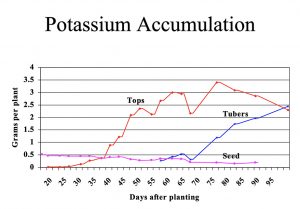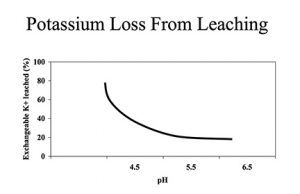Bulletin #2251, Potassium: An Essential Element for Potatoes
Bulletin #2251, Potassium: An Essential Element for Potatoes (PDF)
By Steven B. Johnson, Ph.D., Extension Crops Specialist, University of Maine Cooperative Extension
Reviewed by John Jemison, ExtensionProfessor, Soil and Water Quality, University of Maine Cooperative Extension
For information about UMaine Extension programs and resources, visit extension.umaine.edu.
Find more of our publications and books at extension.umaine.edu/publications/.

Potassium (K) is a macronutrient essential for plant growth. Nitrogen (N) and phosphorus (P) are also essential macronutrients. Fertilizer that is triple 15 contains N-P-K in the ratio of 15-15-15 on a percentage basis. However, the K is not 15% K. It is actually 15% K2O, or potash. K2O is a standard expression of relative K content, even though no K2O occurs in the fertilizer. Fifteen percent K2O actually translates to 12.4% elemental K.
A crop of 300 hundredweight of potato tubers and associated vines needs 100–200 pounds of elemental K per acre, or about 120–240 pounds of K2O. K use by potato is greater than that of N by about 12.5%. The University of Maine soil test reports give K recommendations.
The Role of K in Plants
K is absorbed from the soil by plants in the form K+. K does not form organic compounds in the plant the way N and P do. A major function of K in the potato plant is regulation of water loss. The concentration of K+ ions in the plant’s guard cells causes the stomata to open and close, regulating water loss from leaves. K is also critical to photosynthesis, protein synthesis, and plant metabolism. K is involved in the activation of more than 60 enzyme systems that regulate the rates of major plant growth reactions. It is important in the breakdown of carbohydrates that provide energy for growth. K is also important in the translocation of iron and helps some plants overcome the effects of pathogens, develop fruit properly, and improve winter hardiness.
K Deficiency in Plants
With K critical to photosynthesis, deficiency leads to reduced photosynthesis, increased respiration, lower plant carbohydrate supplies, and lower yields. Potatoes show reduced growth, with poorly developed root systems, smaller leaflets, and shortened internodes, giving the plant a compact appearance. The leaflets lose their smooth surface, become crinkled, and droop. The appearance of abnormally dark green foliage is one of the first indications of potash deficiency. Later, the older leaves become yellowish, and a brown or bronze color develops, starting from the tip and edge and gradually affecting the entire leaf, which finally dies. Under some light conditions, a distinct purplish cast is apparent. The lower leaves may simultaneously dry up, leaving a tuft of dark green leaves at the top of the plant. Eventually, the entire plant dies. The upper leaves are usually smaller, crinkled, and darker green than normal. Black spot bruise and stem end rot increase with K+ deficiency.
K deficiency causes water imbalances and is especially critical in drought situations where the stomates do not close fully, thereby increasing water loss and drought stress.
K Movement in Soils
Some soils may contain 9 tons of K+ per acre. However, most of this is unavailable to the plants. Rarely is more than 5% of the total K available to plants.
K can be mobile in sandy soils or organic soils. Otherwise, K is not very mobile in the soil solution, although water in the soil solution helps disperse K ions short distances. Proper placement of K fertilizer is critical. If the roots don’t grow into the K, it may not be available to the plant. With the root mass of potatoes contacting less than 5% of the soil, it is imperative to have the soil well supplied with K. Any reduction in root growth reduces K uptake.
Plant-Available K
Unavailable K
Many minerals contain K. As rocks and minerals weather, K is released. This soil-forming process occurs so slowly that the K released in this manner is unavailable to potatoes in a growing season. Soil formation occurs closer to geological time than crop phenology time.
Slowly Available K
Slowly available K is fixed between layers of clay. Many clays have high K levels. The higher the clay content of a soil, usually the higher the slowly available K in the soil.
Plant-Available K
Plant-available K is soluble K in the soil solution and the K held in the exchangeable form by soil organic matter and clay particles. The potato plant can take up either exchangeable K or soil solution K. Soil organic matter and clay particles are negatively charged and attract positively charged ions or cations, such as K. The K in solution is usually less than 10 pounds per acre. With the K needs of potato exceeding that of N, 10 pounds per acre is not adequate. As the potato plant removes K from the soil solution, exchangeable K is released into the soil solution. This transfer from the exchangeable sites on soil particles into the soil solution occurs only when the soil contains adequate K reserves for the crop. A potato crop removes a great deal of K, so most potato soils require the addition of K to ensure good yields. Figure 1 shows how the accumulation of K changes within potato plants over the growing season in Maine.

K Sources
When organic matter, crop residues, or synthetic fertilizers release K, it is in the ionic, or charged, form (K+). This ion is attracted to clay and organic matter surfaces and held as exchangeable K. From there it can remain in the soil solution as K+, be taken up by the crop, be leached from soils, or be fixed into a slowly available form.
Maintaining soil pH higher than 5 can preserve some of the K in the soil solution as K can leach from soils with a low pH. Figure 2 shows that leaching loss can be dramatic in low pH soils.
| Source | Analysis (N-P-K) |
|---|---|
| Muriate of potash (KCl) |
0-0-62 |
| Sulfate of potash (K2SO4) | 0-0-50 |
Information in this publication is provided purely for educational purposes. No responsibility is assumed for any problems associated with the use of products or services mentioned. No endorsement of products or companies is intended, nor is criticism of unnamed products or companies implied.
© 2020
Call 800.287.0274 (in Maine), or 207.581.3188, for information on publications and program offerings from University of Maine Cooperative Extension, or visit extension.umaine.edu.
In complying with the letter and spirit of applicable laws and pursuing its own goals of diversity, the University of Maine System does not discriminate on the grounds of race, color, religion, sex, sexual orientation, transgender status, gender, gender identity or expression, ethnicity, national origin, citizenship status, familial status, ancestry, age, disability physical or mental, genetic information, or veterans or military status in employment, education, and all other programs and activities. The University provides reasonable accommodations to qualified individuals with disabilities upon request. The following person has been designated to handle inquiries regarding non-discrimination policies: Director of Equal Opportunity and Title IX Services, 5713 Chadbourne Hall, Room 412, University of Maine, Orono, ME 04469-5713, 207.581.1226, TTY 711 (Maine Relay System).

